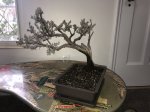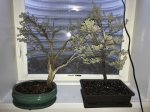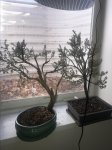Do you guys really think a plant will know the difference between 1 year and 3 years if I control light cycle and moisture on a bush? A pine tree, yes. That’s why mine is sitting in my garage. These are bushes. I kept a plant that is legal in some states not in others in a veg state for 2.5 years. 16 feet tall. Then put in fall light conditions to force flower creation. Amazing results. But I was aiming for huge and that’s what I got. I’m going with these plants think it’s summer. 18 hours of led light per day. Led sucks for growth. But does keep plant alive. Water uptake is noticeable as the leaves shrink and swell as I water. The tap roots were small on these. Like I said, growing in a crack on a cliff face. 1 foot long and 1/4x1” wide. I grabbed the cliff face sage because of the environment it lived in. A ground sage would be impossible. Just what I was thinking. Time will tell.
 The trees (bushes) are doing just fine indoors. I’m happy to have plants in the house I can mess with a bit. I transferred one into a better pot with better soil and will do the same with the other. I’ll have to find out after they have settled for a while if I can clip em shorter and get new growth lower and keep them small. I cleaned off most of the dead outer bark that is super stringy on the one in round pot to expose the cool growth on the stalks. Just a fun mess around project that I thought I’d share. They both came off a cliff face at about 6k feet elevation in Utah. I’m almost thinking I liked the one in the nicer pot laid on it’s side like I had it origenaly and may go back to that.
The trees (bushes) are doing just fine indoors. I’m happy to have plants in the house I can mess with a bit. I transferred one into a better pot with better soil and will do the same with the other. I’ll have to find out after they have settled for a while if I can clip em shorter and get new growth lower and keep them small. I cleaned off most of the dead outer bark that is super stringy on the one in round pot to expose the cool growth on the stalks. Just a fun mess around project that I thought I’d share. They both came off a cliff face at about 6k feet elevation in Utah. I’m almost thinking I liked the one in the nicer pot laid on it’s side like I had it origenaly and may go back to that. 




